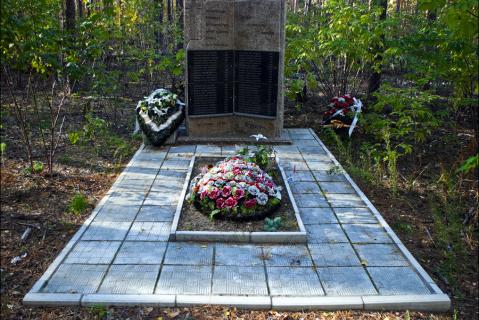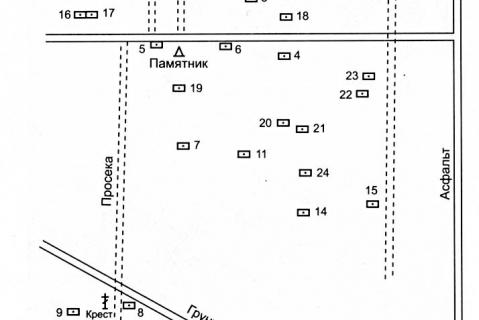“Dubovka” (the oak grove), on the floodplain of the Usmanka river, is today a residential district within the city limits known variously as Dubovka or Somovo. It is one of the places where inhabitants of Voronezh and the Voronezh Region shot at the NKVD inner prison were buried during the Great Terror. Local historians think that about 10,000 lie buried there. In the early 1950s the area was planted with pine trees.
In the late 1980s eyewitnesses reported the location of the burials. At the urging of the chairman of the Voronezh Memorial society, V.I. Bityutsky, exploratory work began. The first burial was found on 6 September 1989 and by 18 October another ten had been discovered. In 1990-1993 24 pits, containing 924 bodies as well as fragments of clothing and personal items, were located and opened. The regional budget financed the work. Exploratory groups engaged in the search received active support from Memorial. Each year new-found remains were solemnly reburied according to Orthodox rites in the location of their discovery. Several large coffins bearing the remains of many people were lowered into each grave and a plaque was placed over it: “Here lie the remains of [number] people”.
The regional prosecutor’s office opened a criminal investigation: witnesses were questioned, and a forensic examination was conducted. In 1992 investigators recognised that the remains belonged to those shot during the Great Terror. The case was closed “for lack of a corpus delicti”.
In 1993 the Voronezh city executive committee declared that the places where burials had been found at Dubovka (86 hectares in extent) would henceforth be a memorial cemetery to the victims of repression in the 1930s and 1940s (decree No. 826 of the head of the city administration, 7 December 1993). Due to a lack of funds work on the exhumation of bodies and their reburial in common graves almost ceased in the mid-1990s. It resumed in 2006. Fifteen pits containing the remains of those shot were opened and their bodies were interred in 15 common graves along the Avenue of Sorrow: a plaque indicating the number of people in the graves was added to each.
In 2009 work halted again due to a lack of funds in the city budget. The following summer the woods around Dubovka suffered severe damage during forest fires. Burnt trees are being felled and new trees planted in areas where there may still be undiscovered execution pits. That is where exploratory work has been proceeding since 2010.
A ceremony of the reburial of human remains on the Avenue of Sorrow has taken place on 30 October each year since 2012. In 2016 the total number of bodies found and reinterred was 3,238. That year the burial site still lacked official status although in practice there existed an agreement with the Voronezh Region Forestry Department to transfer the land for use in perpetuity as a memorial. In the section conditionally designated as the memorial area (about 20 hectares) there are countless personal memorials to individuals and groups: the first was placed there in 1989 by the Voronezh Memorial society. In 2006 the foundation stone of a future chapel in memory of the victims of political repression was consecrated on the Avenue of Sorrow.
There is A Book in Remembrance of the Victims of Political Repression in the Voronezh Region (3 vols 2014-2017); Voronezh Memorial Society has computerised 7,582 biographical entries for those shot or sent to the camps and has also published a two- volume Stalin’s execution lists.
| Date | Nature of ceremonies | Organiser or responsible person | Participants | Frequency |
|---|---|---|---|---|
|
30 October
|
Remembrance Day for the Victims of Political Repression
|
Organised by city commission for Restoration of the Rights of Rehabilitated Victims of Political Repression
|
The public, schoolchildren, members of the city administration
|
annual event
|
|
Commemorative services
|
During interment
|
| State of burials | Area | Boundaries |
|---|---|---|
|
subsidence over burial sites, grave-markers on common graves of the reburied
|
burials cover 86 hectares, of which 20 hectares make up the memorial area
|
partially delineated
|
[ original texts and hyperlinks ]
V.G. Glebov, The blood-soaked sand of Dubovka: inhabitants of Voronezh in the grip of the NKVD, Voronezh, 2004 (160 pp)
Political repression in Voronezh, a Guide (compiled by Akinshin, Bityutsky, Lasunsky and Nikolayev), Krasnoyarsk, 2011 (240 pp)
V.I. Bityutsky, “The tenth reburial in Dubovka”, Human Rights in Russia website, 18 August 2011 [retrieved, 27 May 2022]
“The Dubovka memorial cemetery”, Virtual Museum of the Gulag [retrieved, 27 May 2022]
Reply by the Voronezh Region Administration (№ 21/11-807 of 30 April 2014) to a formal enquiry from RIC Memorial (St Petersburg)




